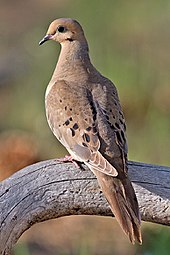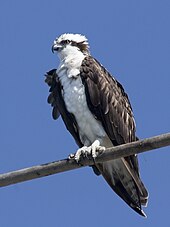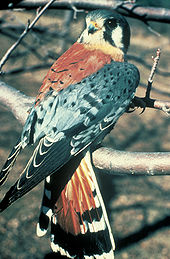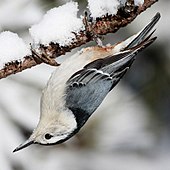


This list of Oregon birds lists wild bird species found in the U.S. stateofOregon and accepted by the Oregon Bird Records Committee (OBRC).[1] As of August 2022, there are 547 species on the list. Of them, 164 are on the review list (see below). Nine species were introduced to Oregon or elsewhere in North America; one of them and two others have been extirpated from the state.
Bird counts often change depending on factors such as the number and training of the observers, as well as opinions about what constitutes an officially recognized subspecies. Though northern climes typically do not support as many species as southerly locations, Oregon is fifth in bird species diversity in the United States, behind Florida, New Mexico, Texas and California.[2] This amount of diversity is attributable to Oregon's numerous distinctive ecoregions and relatively mild winter weather, which make it an important wintering ground for migratory bird species, especially waterfowl, on the Pacific Flyway.
Another result of the state's varying ecology is the 120 Important Bird Areas, such as the Jackson Bottom Wetlands Preserve, that are recognized as important conservation sites for birds.[3] Many of these dedicated wildlife refuges have become meccas for birding enthusiasts, and Oregon has participated in formally organized birding activities such as the Christmas Bird Count since the early 1900s.[4] Other areas are closed to human access but are very popular with birds, such as Oregon Islands National Wildlife Refuge which spans some 250 miles (400 km) of the Oregon Coast.
As an important U.S. region of bird diversity, Oregon has faced some serious challenges in protecting endangered and threatened avian species. In addition to high profile, threatened species such as the northern spotted owl and snowy plover, even many common species—including Oregon's state bird, the western meadowlark—have declined considerably due to hunting, habitat loss and other factors.[5]
This list is presented in the taxonomic sequence of the Check-list of North and Middle American Birds, 7th edition through the 62nd Supplement, published by the American Ornithological Society (AOS).[6] Common and scientific names are also those of the Check-list, except that the common names of families are from the Clements taxonomy because the AOS list does not include them.
Unless otherwise noted, all species listed below are considered to occur regularly in Oregon as permanent residents, summer or winter visitors, or migrants. These tags are used to annotate some species:





Order: Anseriformes Family: Anatidae
The family Anatidae includes the ducks and most duck-like waterfowl, such as geese and swans. These birds are adapted to an aquatic existence with webbed feet, bills which are flattened to a greater or lesser extent, and feathers that are excellent at shedding water due to special oils.

Order: Galliformes Family: Odontophoridae
The New World quails are small, plump terrestrial birds only distantly related to the quails of the Old World, but named for their similar appearance and habits.
Order: Galliformes Family: Phasianidae
Phasianidae consists of the pheasants and their allies, including partridges, grouse, turkeys, and Old World quail. These are terrestrial species, variable in size but generally plump with broad relatively short wings. Many species are gamebirds or have been domesticated as a food source for humans.

Order: Podicipediformes Family: Podicipedidae
Grebes are small to medium-large freshwater diving birds. They have lobed toes and are excellent swimmers and divers. However, they have their feet placed far back on the body, making them quite ungainly on land.

Order: Columbiformes Family: Columbidae
Pigeons and doves are stout-bodied birds with short necks and short slender bills with a fleshy cere.

Order: Cuculiformes Family: Cuculidae
The family Cuculidae includes cuckoos, roadrunners, and anis. These birds are of variable size with slender bodies, long tails, and strong legs. The Old World cuckoos are brood parasites.
Order: Caprimulgiformes Family: Caprimulgidae
Nightjars are medium-sized nocturnal birds that usually nest on the ground. They have long wings, short legs, and very short bills. Most have small feet, of little use for walking, and long pointed wings. Their soft plumage is cryptically colored to resemble bark or leaves.
Order: Apodiformes Family: Apodidae
The swifts are small birds which spend the majority of their lives flying. These birds have very short legs and never settle voluntarily on the ground, perching instead only on vertical surfaces. Many swifts have long swept-back wings which resemble a crescent or boomerang.
Order: Apodiformes Family: Trochilidae
Hummingbirds are small birds capable of hovering in mid-air due to the rapid flapping of their wings. They are the only birds that can fly backwards.
Order: Gruiformes Family: Rallidae
Rallidae is a large family of small to medium-sized birds which includes the rails, crakes, coots, and gallinules. The most typical family members occupy dense vegetation in damp environments near lakes, swamps, or rivers. In general they are shy and secretive birds, making them difficult to observe. Most species have strong legs and long toes which are well adapted to soft uneven surfaces. They tend to have short, rounded wings and to be weak fliers.
Order: Gruiformes Family: Gruidae
Cranes are large, long-legged, long-necked birds. Unlike the similar-looking but unrelated herons, cranes fly with necks outstretched, not pulled back. Most have elaborate and noisy courting displays or "dances".

Order: Charadriiformes Family: Recurvirostridae
Recurvirostridae is a family of large wading birds which includes the avocets and stilts. The avocets have long legs and long up-curved bills. The stilts have extremely long legs and long, thin, straight bills.

Order: Charadriiformes Family: Haematopodidae
The oystercatchers are large, obvious, and noisy plover-like birds, with strong bills used for smashing or prising open molluscs.


Order: Charadriiformes Family: Charadriidae
The family Charadriidae includes the plovers, dotterels, and lapwings. They are small to medium-sized birds with compact bodies, short thick necks, and long, usually pointed, wings. They are found in open country worldwide, mostly in habitats near water.




Order: Charadriiformes Family: Scolopacidae
Scolopacidae is a large diverse family of small to medium-sized shorebirds including the sandpipers, curlews, godwits, shanks, tattlers, woodcocks, snipes, dowitchers, and phalaropes. The majority of these species eat small invertebrates picked out of the mud or soil. Different lengths of legs and bills enable multiple species to feed in the same habitat, particularly on the coast, without direct competition for food.

Order: Charadriiformes Family: Stercorariidae
Skuas and jaegers are in general medium to large birds, typically with gray or brown plumage, often with white markings on the wings. They have longish bills with hooked tips and webbed feet with sharp claws. They look like large dark gulls, but have a fleshy cere above the upper mandible. They are strong, acrobatic fliers.

Order: Charadriiformes Family: Alcidae
Alcids are superficially similar to penguins due to their black-and-white colors, their upright posture, and some of their habits. However, they are only distantly related to the penguins and are able to fly. Auks live on the open sea, only deliberately coming ashore to nest.



Order: Charadriiformes Family: Laridae
Laridae is a family of medium to large seabirds and includes gulls, terns, kittiwakes, and skimmers. They are typically gray or white, often with black markings on the head or wings. They have stout, longish bills and webbed feet.
Order: Phaethontiformes Family: Phaethontidae
Tropicbirds are slender white birds of tropical oceans with exceptionally long central tail feathers. Their long wings have black markings, as does the head.

Order: Gaviiformes Family: Gaviidae
Loons are aquatic birds, the size of a large duck, to which they are unrelated. Their plumage is largely gray or black, and they have spear-shaped bills. Loons swim well and fly adequately, but are almost hopeless on land, because their legs are placed towards the rear of the body.

Order: Procellariiformes Family: Diomedeidae
The albatrosses are amongst the largest of flying birds, and the great albatrosses from the genus Diomedea have the largest wingspans of any extant birds.
Order: Procellariiformes Family: Oceanitidae
The storm-petrels are the smallest seabirds, relatives of the petrels, feeding on planktonic crustaceans and small fish picked from the surface, typically while hovering. The flight is fluttering and sometimes bat-like. Until 2018, this family's three species were included with the other storm-petrels in family Hydrobatidae.
Order: Procellariiformes Family: Hydrobatidae
Though the members of this family are similar in many respects to the southern storm-petrels, including their general appearance and habits, there are enough genetic differences to warrant their placement in a separate family.

Order: Procellariiformes Family: Procellariidae
The procellariids are the main group of medium-sized "true petrels", characterized by united nostrils with medium septum and a long outer functional primary.
Order: Suliformes Family: Fregatidae
Frigatebirds are large seabirds usually found over tropical oceans. They are large, black or black-and-white, with long wings and deeply forked tails. The males have colored inflatable throat pouches. They do not swim or walk and cannot take off from a flat surface. Having the largest wingspan-to-body-weight ratio of any bird, they are essentially aerial, able to stay aloft for more than a week.

Order: Suliformes Family: Sulidae
The sulids comprise the gannets and boobies. Both groups are medium-large coastal seabirds that plunge-dive for fish.

Order: Suliformes Family: Phalacrocoracidae
Cormorants are medium-to-large aquatic birds, usually with mainly dark plumage and areas of colored skin on the face. The bill is long, thin, and sharply hooked. Their feet are four-toed and webbed.
Order: Pelecaniformes Family: Pelecanidae
Pelicans are very large water birds with a distinctive pouch under their beak. Like other birds in the order Pelecaniformes, they have four webbed toes.


Order: Pelecaniformes Family: Ardeidae
The family Ardeidae contains the herons, egrets, and bitterns. Herons and egrets are medium to large wading birds with long necks and legs. Bitterns tend to be shorter-necked and more secretive. Members of Ardeidae fly with their necks retracted, unlike other long-necked birds such as storks, ibises, and spoonbills.
Order: Pelecaniformes Family: Threskiornithidae
The family Threskiornithidae includes the ibises and spoonbills. They have long, broad wings. Their bodies tend to be elongated, the neck more so, with rather long legs. The bill is also long, decurved in the case of the ibises, straight and distinctively flattened in the spoonbills.
Order: Cathartiformes Family: Cathartidae
The New World vultures are not closely related to Old World vultures, but superficially resemble them because of convergent evolution. Like the Old World vultures, they are scavengers. However, unlike Old World vultures, which find carcasses by sight, New World vultures have a good sense of smell with which they locate carcasses.

Order: Accipitriformes Family: Pandionidae
Pandionidae is a monotypic family of fish-eating birds of prey. Its single species possesses a very large and powerful hooked beak, strong legs, strong talons, and keen eyesight.
Order: Accipitriformes Family: Accipitridae
Accipitridae is a family of birds of prey which includes hawks, eagles, kites, harriers, and Old World vultures. These birds have very large powerful hooked beaks for tearing flesh from their prey, strong legs, powerful talons, and keen eyesight.
Order: Strigiformes Family: Tytonidae
Barn-owls are medium to large owls with large heads and characteristic heart-shaped faces. They have long strong legs with powerful talons.


Order: Strigiformes Family: Strigidae
Typical owls are small to large solitary nocturnal birds of prey. They have large forward-facing eyes and ears, a hawk-like beak, and a conspicuous circle of feathers around each eye called a facial disk.
Order: Coraciiformes Family: Alcedinidae
Kingfishers are medium-sized birds with large heads, long pointed bills, short legs, and stubby tails.


Order: Piciformes Family: Picidae
Woodpeckers are small to medium-sized birds with chisel-like beaks, short legs, stiff tails, and long tongues used for capturing insects. Some species have feet with two toes pointing forward and two backward, while several species have only three toes. Many woodpeckers have the habit of tapping noisily on tree trunks with their beaks.

Order: Falconiformes Family: Falconidae
Falconidae is a family of diurnal birds of prey, notably the falcons and caracaras. They differ from hawks, eagles, and kites in that they kill with their beaks instead of their talons.



Order: Passeriformes Family: Tyrannidae
Tyrant flycatchers are Passerine birds which occur throughout North and South America. They superficially resemble the Old World flycatchers, but are more robust and have stronger bills. They do not have the sophisticated vocal capabilities of the songbirds. Most, but not all, are rather plain. As the name implies, most are insectivorous.

Order: Passeriformes Family: Vireonidae
The vireos and greenlets are a group of small to medium-sized passerine birds mostly restricted to the New World, though a few members of the family, called shrike-babblers, are found in Asia. They are typically greenish in color and resemble wood-warblers apart from their heavier bills
Order: Passeriformes Family: Laniidae
Shrikes are passerine birds known for their habit of catching other birds and small animals and impaling the uneaten portions of their bodies on thorns. A shrike's beak is hooked, like that of a typical bird of prey.


Order: Passeriformes Family: Corvidae
The family Corvidae includes crows, ravens, jays, choughs, magpies, treepies, nutcrackers, and ground jays. Corvids are above average in size among the Passeriformes, and some of the larger species show high levels of intelligence.

Order: Passeriformes Family: Paridae
The Paridae are mainly small stocky woodland species with short stout bills. Some have crests. They are adaptable birds, with a mixed diet including seeds and insects.
Order: Passeriformes Family: Alaudidae
Larks are small terrestrial birds with often extravagant songs and display flights. Most larks are fairly dull in appearance. Their food is insects and seeds.

Order: Passeriformes Family: Hirundinidae
The family Hirundinidae is adapted to aerial feeding. They have a slender streamlined body, long pointed wings, and a short bill with a wide gape. The feet are adapted to perching rather than walking, and the front toes are partially joined at the base.
Order: Passeriformes Family: Aegithalidae
The long-tailed tits are a family of small passerine birds with medium to long tails. They make woven bag nests in trees. Most eat a mixed diet which includes insects.
Order: Passeriformes Family: Phylloscopidae
Leaf warblers are a family of small insectivorous birds found mostly in Eurasia and ranging into Wallacea and Africa. The Arctic warbler breeds east into Alaska. The species are of various sizes, often green-plumaged above and yellow below, or more subdued with grayish-green to grayish-brown colors.
Order: Passeriformes Family: Sylviidae
The family Sylviidae is a group of small insectivorous passerine birds. They mainly occur as breeding species, as the common name implies, in Europe, Asia, and to a lesser extent Africa. Most are of generally undistinguished appearance, but many have distinctive songs.
Order: Passeriformes Family: Regulidae
The kinglets are a small family of birds which resemble the titmice. They are very small insectivorous birds. The adults have colored crowns, giving rise to their name.

Order: Passeriformes Family: Bombycillidae
The waxwings are a group of birds with soft silky plumage and unique red tips to some of the wing feathers. In the Bohemian and cedar waxwings, these tips look like sealing wax and give the group its name. These are arboreal birds of northern forests. They live on insects in summer and berries in winter.
Order: Passeriformes Family: Ptiliogonatidae
The silky-flycatchers are a small family of passerine birds which occur mainly in Central America. They are related to waxwings and most species have small crests.

Order: Passeriformes Family: Sittidae
Nuthatches are small woodland birds. They have the unusual ability to climb down trees head first, unlike other birds which can only go upwards. Nuthatches have big heads, short tails, and powerful bills and feet.
Order: Passeriformes Family: Certhiidae
Treecreepers are small woodland birds, brown above and white below. They have thin pointed down-curved bills, which they use to extricate insects from bark. They have stiff tail feathers, like woodpeckers, which they use to support themselves on vertical trees.
Order: Passeriformes Family: Polioptilidae
These dainty birds resemble Old World warblers in their structure and habits, moving restlessly through the foliage seeking insects. The gnatcatchers are mainly soft bluish gray in color and have the typical insectivore's long sharp bill. Many species have distinctive black head patterns (especially males) and long, regularly cocked, black-and-white tails.

Order: Passeriformes Family: Troglodytidae
Wrens are small and inconspicuous birds, except for their loud songs. They have short wings and thin down-turned bills. Several species often hold their tails upright. All are insectivorous.
Order: Passeriformes Family: Mimidae
The mimids are a family of passerine birds which includes thrashers, mockingbirds, tremblers, and the New World catbirds. These birds are notable for their vocalization, especially their remarkable ability to mimic a wide variety of birds and other sounds heard outdoors. The species tend towards dull grays and browns in their appearance.
Order: Passeriformes Family: Sturnidae
Starlings are small to medium-sized Old World passerine birds with strong feet. Their flight is strong and direct and most are very gregarious. Their preferred habitat is fairly open country, and they eat insects and fruit. The plumage of several species is dark with a metallic sheen.

Order: Passeriformes Family: Cinclidae
Dippers are a group of perching birds whose habitat includes aquatic environments in the Americas, Europe, and Asia. They are named for their bobbing or dipping movements. These birds have adaptations which allows them to submerge and walk on the bottom to feed on insect larvae.


Order: Passeriformes Family: Turdidae
The thrushes are a group of passerine birds that occur mainly but not exclusively in the Old World. They are plump, soft plumaged, small to medium-sized insectivores or sometimes omnivores, often feeding on the ground. Many have attractive songs.
Order: Passeriformes Family: Muscicapidae
The Old World flycatchers form a large family of small passerine birds. These are mainly small arboreal insectivores, many of which, as the name implies, take their prey on the wing.
Order: Passeriformes Family: Passeridae
Old World sparrows are small passerine birds. In general, sparrows tend to be small plump brownish or grayish birds with short tails and short powerful beaks. Sparrows are seed eaters, but they also consume small insects.

Order: Passeriformes Family: Motacillidae
Motacillidae is a family of small passerine birds with medium to long tails. They include the wagtails, longclaws, and pipits. They are slender ground-feeding insectivores of open country.

Order: Passeriformes Family: Fringillidae
Finches are seed-eating passerine birds that are small to moderately large and have a strong beak, usually conical and in some species very large. All have twelve tail feathers and nine primaries. These birds have a bouncing flight with alternating bouts of flapping and gliding on closed wings, and most sing well.
Order: Passeriformes Family: Calcariidae
The Calcariidae are a group of passerine birds that had been traditionally grouped with the New World sparrows, but differ in a number of respects and are usually found in open grassy areas.
Order: Passeriformes Family: Emberizidae
Emberizidae is a family of passerine birds containing a single genus. Until 2017, the New World sparrows (Passerellidae) were also considered part of this family.




Order: Passeriformes Family: Passerellidae
Until 2017, these species were considered part of the family Emberizidae. Most of the species are known as sparrows, but these birds are not closely related to the Old World sparrows which are in the family Passeridae. Many of these have distinctive head patterns.
Order: Passeriformes Family: Icteriidae
This species was historically placed in the wood-warblers (Parulidae) but nonetheless most authorities were unsure if it belonged there. It was placed in its own family in 2017
Order: Passeriformes Family: Icteridae
The icterids are a group of small to medium-sized, often colorful passerine birds restricted to the New World and include the grackles, New World blackbirds, and New World orioles. Most species have black as a predominant plumage color, often enlivened by yellow, orange, or red.




Order: Passeriformes Family: Parulidae
The wood warblers are a group of small and often colorful passerine birds restricted to the New World. Most are arboreal, but some are more terrestrial. Most members of this family are insectivores.


Order: Passeriformes Family: Cardinalidae
The cardinals are a family of robust seed-eating birds with strong bills. They are typically associated with open woodland. The sexes usually have distinct plumages.